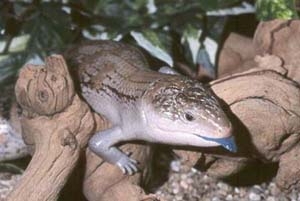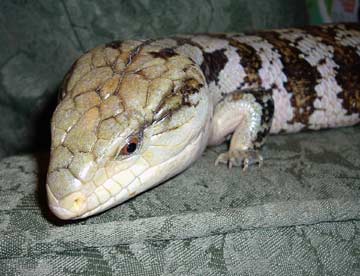Tropical Skink - blue-tongued
Habitat: Open woodlands, semi-desert, tropical or agricultural areas Blue-tongued skinks come from Australia, Tasmania and New Guinea. They are a very popular pet lizard. This is due to their gentle disposition, longevity, overall beauty and ease of care. Blue-tongued skinks are ground-dwelling animals, found under bark and other vegetation. They are primarily active during the day, usually moving quite slowly but like all lizards, they can move very quickly in an emergency.
Skinks have a stout body with relatively small limbs and a thick, short tail. Broad, blunt triangular head and scales that are usually smooth and contain small plates of bone. Deep, berry blue tongue vividly offsets against the deep pink interior of the mouth. Skinks usually are solitary animals, living secretive lives until mating season. They are only active during the warmer months. Mating occurs in November or December. Females only reproduce every second year and give birth to an average of six live young.
DO NOT FEED WILD INSECTS OR INSECTS FOUND AROUND THE HOUSE – THEY MAY CARRY DISEASES THAT COULD BE DEADLY TO YOUR PET
Average Size - Up to 32 inches long
Life Span - Up to 15+ years with proper care
Diet - they are omnivores (both plant and animal) and eat plant-matter (60%) and insects and worms (40%); include plant-matter as listed below and gut-loaded (recently fed), crickets, mealworms, and waxworms
Feeding - Feed adults every other day; juveniles daily; provide a multiple vitamin/mineral supplement once or twice a week and calcium daily
Housing - Due to the varied sizes and growth rates of reptiles, you can “grow” your skink into an adequate habitat. Appropriate size and shape habitat to accommodate normal behaviors and exercise. A rule of thumb: Hatchlings can be kept in 10 gal. Adults require at least 40-55 gal tanks.
Substrate - Use pelleted or mulch-type; skinks may eat their substrate; if they do, switch to something they cannot eat, like paper or cage carpet, or an edible substrate. The substrate can also be pine (NOT cedar) shavings, aspen shavings or cypress mulch.
Habitat - They need a hide box. They are ground dwellers and so do not need tall branches or rocks for climbing. They CAN climb, however, so top-opening tanks do need to be securely fastened. One area of slightly damp substrate should be kept, or a humidity retreat box (into which they can freely climb in and out, filled with damp sphagnum moss, for use during shed periods).
Temperature - The overall gradient should range from the mid 70s on the cool side to the mid 80s on the warm side. A slightly warmer basking area, with temps into the low 90s, may also be provided during the day. A people heating pad under the tank at one end, and a radiant heat source overhead at the same end, will generally be all that is required to establish the gradient. Cold winter weather may require additional heating or a stronger bulb.
Lighting - Provide needed UVB rays with full spectrum fluorescent light for 10 to 12 hours a day; incandescent light is needed for basking area
Water - Have a shallow dish of clean, chlorine-free water always available for drinking; mist habitat frequently to maintain high humidity
Normal Behavior and Interaction Most tropical skinks are semi-nocturnal and will spend a portion of daylight hours hiding Skinks are not naturally tame; significant time must be spent with them to maintain your ability to handle them; skinks have a powerful bite if highly stressed or untamed; children should only handle skinks with adult supervision
Recommended Supplies:
- Recommended Supplies
- Habitat with secure lid
- Humidity gauge
- Full spectrum fluorescent light
- Basking log
- Heat source
|
- Incandescent basking light
- Substrate, non-toxic plants
- Thermometer
- Vitamin/mineral supplement
- Book about tropical skinks
| Grooming and Hygiene Change water; remove feces daily. Thoroughly clean the tank at least once a week: set tropical skink aside in a secure habitat; scrub the tank and furnishings with a 3% bleach solution; rinse thoroughly with water, removing all smell of bleach; rinse all plants with clean water; add clean substrate. Trim nails at regular intervals
Juveniles shed more frequently than adults. Healthy adults should not shed more frequently than every six weeks. Because shedding takes a considerable investment of energy, it tends to redirect bodily resources away from regular food metabolism. Thus, time between defecations may be lengthened considerably when a shed is imminent. Always wash your hands before and after touching your skink or habitat contents to help prevent Salmonella and other infectious diseases. Skinks regularly shed their skin; ensure humidity of habitat is appropriate to allow proper shedding; to facilitate shedding, bathe in a large container or tub that allows the skink to immerse entire body
Signs of a Healthy Pet:
- Active and alert Healthy skin Clear eyes
- Eats regularly
|
- Clear nose and vent
- Body and tail are rounded and full
| Common Health Issues and Red Flags:
- Weight loss or decreased appetite
- Mucus in mouth or nose
- Swelling
- Lethargy
|
- Bumps, sores, or abrasions on skin
- Labored breathing
- Paralysis of limbs or tail
- Abnormal feces
|
If you notice any of these signs, please contact your exotic animal veterinarian.
As with all pets in this category, it is important that you find a veterinarian that practices in EXOTICS – this is critical. The typical small animal practitioner may not have sufficient knowledge in this area. Even this guide is general in nature and should not be used to diagnose your pet.
|



